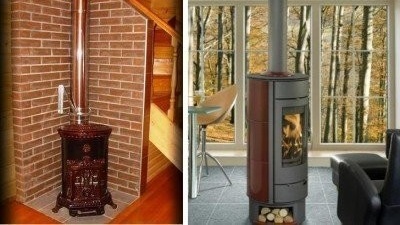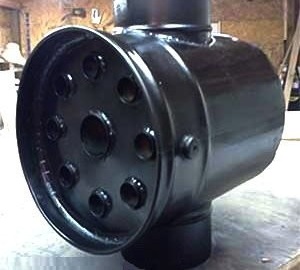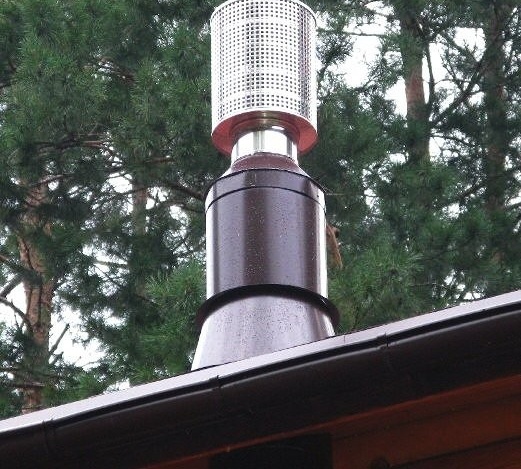How to make a chimney for a stove: the simplest chimney in steps
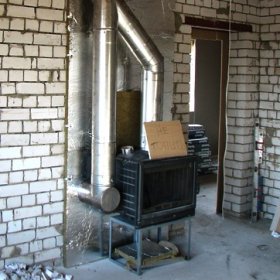
A potbelly stove is a stove with a rich history and a huge number of modifications. Its low cost and mobility have attracted summer residents from the beginning of the twentieth century. And now, a stove is preferred for profitability and, often, for an attractive aesthetic appearance. This small stove is also a heater, a stove for cooking, a fireplace and an elegant piece of furniture. One of the main advantages of a potbelly stove is its modest overall dimensions. For its installation, it is enough to determine what and how to make a chimney for a stove. The choice must be made between asbestos-cement pipes and metal. The latter greatly facilitate the design and less often cause difficulties in the installation process.
Features of the "bourgeois" chimney
The chimney in the potbelly stove consists of two parts:
- heat exchange;
- gas outlet.
The output pipe practically did not change over time. Previously, an ordinary metal pipe that went outside was directly connected to a potbelly stove. Now they use certain materials, and the chimney is connected either after the damper that blocks the outlet after the end of combustion, or to the chimney.
Inside the housing is located the heat exchange part of the pipe. As an improved and fireproof version of the design, a knee chimney is installed in potbelly stoves. The shape of its heat exchange elements and their location determine the type of furnace and the design of the chimney. The stoves elongated in the horizontal plane are equipped with a “smoke chamber” or a “hood”. In such designs, the exhaust gases through the hole in the side wall fall into this department, thereby increasing the heat transfer of the potbelly stove, and only after that “fly out into the pipe”.
Stoves stretched vertically have a more complex chimney arrangement. They use the same knee system in which spiral channels are used along with the knee to increase heat transfer. This design delays smoke and extends the life of the furnace.
The procedure for the manufacture and installation of the structure
Doing a brick chimney for a stove yourself is hardly worth it. For a mobile oven, it is too bulky, material-intensive and expensive. Asbestos-cement pipes can, of course, be used, but there are several significant drawbacks:
- temperature threshold - 300 ° C;
- fast soot overgrowing due to rough inner surface;
- fire hazard. Soot accumulated in the pipe will catch fire sooner or later, and an asbestos-cement chimney will not withstand this temperature;
- the gradual destruction of asbestos due to the reaction with hydrochloric acid contained in the oxides;
- absorption of condensate and its subsequent transfer to the walls and roof, which causes the appearance of spots and fetid odor.
Metal chimney is much easier to make and install yourself. Subject to the rules and regulations, even a layman can ensure fire safety and proper operation of the stove.
The correct chimney for the potbelly stove should be made of alloy steel, a special coating of which will protect the pipe from the harmful effects of oxides. When it comes to a stove installed on the street, the manufacture and installation of the chimney consists in picking up a pipe of the right diameter and “sticking” it into the desired hole. The stove, in this case, is used as a stove, and a chimney is needed, rather, so that the smoke does not swirl over the pots and does not pinch your eyes.
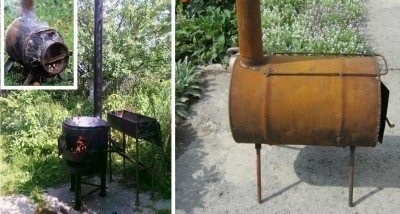
If the potbelly stove is on the street and is used as a stove, then the installation of the chimney is reduced to simply “sticking” the pipe into the pipe
For a potbelly stove installed in the room, they make a chimney with a knee system. Buying metal pipes or making them from sheet metal is a personal matter for everyone. Usually, if the diameter of the furnace branch pipe is standard, no one bothers with homemade products, but if the furnace is non-standard in all respects, then you will have to do everything on your own.
To install a chimney on a stove, you need the following materials (we are talking about a stove installed in a room with a chimney of standard sizes):
- one elbow 100 * 1200 mm;
- two elbows 160 * 1200 mm;
- three knees for a joint 160 * 100 millimeters;
- tee 160 mm with a plug;
- 200 mm fungus;
- sealant.
In addition, you may need a walk-through glass, an anti-spill visor, thermal insulation and other materials. It all depends on the type of room in which the heater is located.
The internal chimney, located in the room, and the external, facing the street, are joined in the attic or in the under-roof space.
When installing a chimney for a stove, the first pipe section is fixed in the furnace pipe or in the chimney hole. Then the knee extends to the floor.
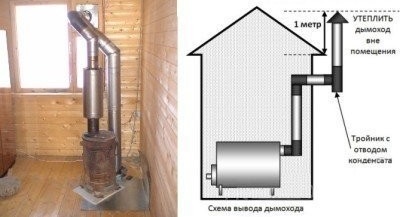
The chimney can be removed both up through the ceiling and roof, and through the window. In this case, the passage glass is installed in the glass hole
A hole of the corresponding diameter is cut out in the ceiling plate, along the edges of which the thermal insulation is necessarily removed, and a passage glass is installed. A pipe is passed through it and joined with an external chimney. The latter needs to provide thermal insulation and cover with bitumen. A fungus or spark arrestor is installed on top of the chimney pipe, protecting the pipe from small debris, precipitation, livestock, and flying sparks.
Rules and features of chimney care
Proper and efficient operation of the stove is dependent on the condition of the chimney. And he needs systematic care:
- once a year it is necessary to inspect the outer part of the pipe for rust, burnouts, cracks and other defects;
- annually need to clean the chimney from soot. For this, a special chemical composition is burned in the furnace along with fuel. Alternatively, you can throw aspen firewood into the furnace. When burning, they give a very high temperature, which burns soot.
Keep in mind that using a kettlebell or ruff for mechanical cleaning the chimney of soot can damage brittle metal pipes.
If you responsibly approach the installation of the stove and the installation of the chimney, then with proper preparation there will be no problems. It is important to remember that a potbelly stove is the same heating device as a boiler or fireplace, and if used improperly, it can cause a fire. Neglecting the rules and regulations is categorically impossible.
